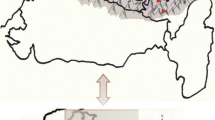Abstract
Culturable chitinolytic bacterial diversity was studied in chitin-rich soils collected from two industries involved in chitin production. A total of 27 chitinolytic isolates were isolated among which only 10 showed zone of clearance ≥4 mm on colloidal chitin agar plate. Using morphological, biochemical and 16S rDNA analysis, isolates were identified as Bacillus, Paenibacillus, Stenotrophomonas and Pseudomonas. Molecular phylogenetic analysis revealed that Gammaproteobacteria and Bacilli were found to be the predominant classes in these chitin-enriched soils. Chitinolytic bacterial population densities were significantly high and showed a rather simple community composition dominated by genus Bacillus and Stenotrophomonas (74%). This is the first report on assessing the chitinolytic bacterial diversity of soils from industries involved in chitin production.



Similar content being viewed by others
References
Benson HJ (1990) Microbiological applications-a laboratory manual in general microbiology. WMC Brown Publishers, Boulevard
Berger LR, Reynolds DM (1988) Colloidal chitin preparation. Methods Enzymol 161:140–142
Bhattacharya D, Nagpure A, Gupta RK (2007) Bacterial chitinases: properties and potential. Crit Rev Biotechnol 27(1):21–28
Cody RM (1989) Distribution of chitinase and chitobiase in Bacillus. Curr Microbiol 19:201–205
Girvan MS, Bullimore J, Pretty N, Osborn AM, Ball AS (2003) Soil type is the primary determinant of the composition of the total and active bacterial communities in arable soils. Appl Environ Microbiol 69:1800–1809
Gonzalez-Franco AC, Deobald LA, Spivak A, Crawford DL (2003) Actinobacterial chitinase like enzymes: profile of rhizosphere versus non-rhizosphere isolates. Can J Microbiol 49:683–698
Holt JG, Krieg NR, Sneath PH (1994) Bergey’s manual of determinative bacteriology. Williams and Wilkins Pub, Philadelphia
Howard MB, Ekborg AN, Weiner RM, Hutcheson SW (2003) Detection and characterization of chitinases and other chitin-modifying enzymes. J Ind Microbiol Biotechnol 30:623–635
Kamil Z, Rizk M, Saleh M, Moustafa M (2007) Isolation and identification of rhizosphere soil chitinolytic bacteria and their potential in antifungal biocontrol. Global J Mol Sci 2(2):57–66
Kim HS, Timmis KN, Golyshin PN (2007) Characterization of a chitinolytic enzyme from Serratia sp. KCK isolated from kimchi juice. Appl Microbiol Biotechnol 75:1275–1283
Kishore GK, Pande S, Podile AR (2005a) Phylloplane bacteria increase seedling emergence growth and yield of field-grown groundnut (Arachis hypogaea L.). Lett Appl Microbiol 40:260–268
Kishore GK, Pande S, Podile AR (2005b) Biological control of late leaf spot of peanut (Arachis hypogaea) with chitinolytic bacteria. Phytopathology 95:1157–1165
Kumar S, Dudley J, Nei M, Tamura K (2008) MEGA: a biologist-centric software for evolutionary analysis of DNA and protein sequences. Brief Bioinform 9:299–306
Kurita K (2006) Chitin and chitosan: functional biopolymers from marine crustaceans. Mar Biotechnol 8:203–226
Nishimura T, Toyota K, Mochizuki M (2005) Predominant culturable Bacillus species in Japanese arable soils and their potential as biocontrol agents. Microb Environ 20:61–68
Poulsen PHB, Møller J, Magid J (2008) Determination of a relationship between chitinase activity and microbial diversity in chitin amended compost. Bioresource Technol 99:4355–4359
Sambrook J, Russell DW (2001) Molecular cloning: a laboratory manual. Cold Spring Harbor Laboratory Press, Cold Spring Harbor
Smit E, Leeflang P, Gommans S, van den Broek J, van Mill S, Wernars K (2001) Diversity and seasonal fluctuations of the dominant members of the bacterial soil community in a wheat field as determined by cultivation and molecular methods. Appl Environ Microbiol 67:2284–2291
Tharanathan RN, Kittur FS (2003) Chitin-the undisputed biomolecules of great potential. Crit Rev Food Sci Nutr 43:61–87
Wang S, Hwang J (2001) Microbial reclamation of shellfish wastes for the production of chitinases. Enzy Microb Technol 28:376–382
Wang SL, Chio SH, Chang WT (1997) Production of chitinase from shell-fish wastes by Pseudomonas aeruginosa K-187. Proc Natl Sci Counc ROC (B) 21:71–79
Yasir M, Aslam Z, Kim SW, Lee S, Jeon CO, Chung YR (2009) Bacterial community composition and chitinase gene diversity of vermicompost with antifungal activity. Bioresour Technol 100:4395–4403
Zhu X, Zhou Y, Fenf J (2007) Analysis of both chitinase and chitosanase produced by Sphingomonas sp. CJ-5. J Zhejiang Univ Sci 8:831–838
Acknowledgments
We gratefully acknowledge the financial support under University Grants Commission-Centre for Advanced Studies (UGC-CAS), Department of Biotechnology-Centre for Research and Education in Biology and Biotechnology (DBT-CREBB) program to the School of Life Sciences and Department of Science and Technology-Fund for Improvement of Science and Technology Infrastructure in Universities and Higher Educational Institutions (DST-FIST) programs to the Department of Plant Sciences, University of Hyderabad, and Prof. Ch. Venkata Ramana for his guidance in molecular characterization of bacterial isolates. SND and PVSRN thank DST-Centre for Nanoscience and DBT, respectively for research fellowships. We thank Dr. Domnique Gillet and Dr. Prasuna K. from Mahatani Chitosan and S. M. Agritech, respectively for providing the chitin-rich soil samples from their factory premises.
Author information
Authors and Affiliations
Corresponding author
Rights and permissions
About this article
Cite this article
Das, S.N., Sarma, P.V.S.R.N., Neeraja, C. et al. Members of Gammaproteobacteria and Bacilli represent the culturable diversity of chitinolytic bacteria in chitin-enriched soils. World J Microbiol Biotechnol 26, 1875–1881 (2010). https://doi.org/10.1007/s11274-010-0369-8
Received:
Accepted:
Published:
Issue Date:
DOI: https://doi.org/10.1007/s11274-010-0369-8




